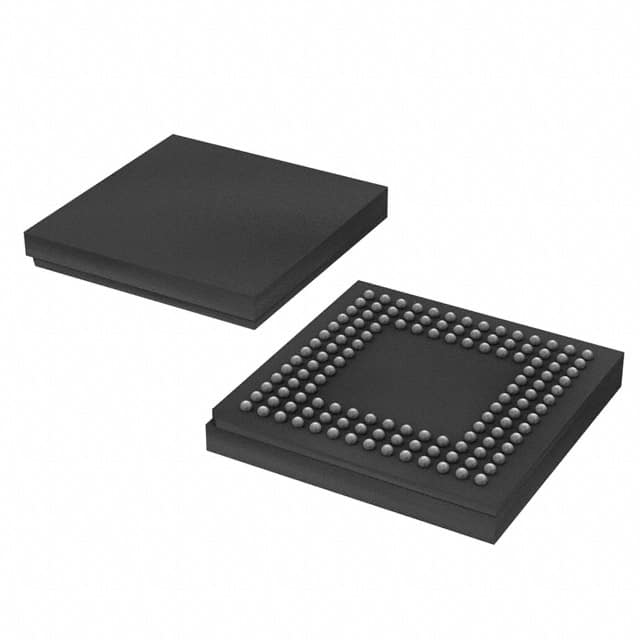Lihat spesifikasi untuk detail produk.

XC2C128-7CPG132I
Product Overview
Category
XC2C128-7CPG132I belongs to the category of programmable logic devices (PLDs).
Use
This product is commonly used in digital circuit design and implementation. It provides a flexible and customizable solution for various applications.
Characteristics
- Programmable: The XC2C128-7CPG132I can be programmed to perform specific functions based on user requirements.
- High-density: It offers a large number of configurable logic blocks, allowing for complex designs.
- Low power consumption: The device is designed to operate efficiently with minimal power consumption.
- Fast performance: The XC2C128-7CPG132I offers high-speed operation, enabling quick execution of tasks.
Package
The XC2C128-7CPG132I comes in a compact plastic package, which ensures protection against external factors such as moisture and dust.
Essence
The essence of this product lies in its ability to provide a reconfigurable hardware platform that allows users to implement custom digital circuits.
Packaging/Quantity
The XC2C128-7CPG132I is typically packaged in reels or trays, depending on the quantity ordered. The exact packaging quantity may vary based on customer requirements.
Specifications
- Device type: Programmable logic device (PLD)
- Family: XC2C
- Logic cells: 128
- Speed grade: -7
- Package: CPG132I
- Operating voltage: 3.3V
- I/O standards: LVTTL, LVCMOS
Detailed Pin Configuration
The XC2C128-7CPG132I has a total of 132 pins, each serving a specific purpose in the device's functionality. The pin configuration is as follows:
(Pin Number) - (Pin Name) - (Function) 1 - VCCO0 - Output voltage supply 2 - GND - Ground 3 - IOL1PT0AD0N0 - Input/output pin 4 - IOL1NT1AD1P0 - Input/output pin 5 - IOL2PT2AD2N0 - Input/output pin 6 - IOL2NT3AD3P_0 - Input/output pin ... 132 - VREFP - Reference voltage
Functional Features
The XC2C128-7CPG132I offers several functional features that make it a versatile choice for digital circuit design:
- Reconfigurability: The device can be reprogrammed multiple times, allowing for iterative design improvements and flexibility in adapting to changing requirements.
- High-speed operation: With its advanced architecture, the XC2C128-7CPG132I can handle complex operations at high speeds, ensuring efficient execution of tasks.
- Large logic capacity: The 128 logic cells provide ample space for implementing complex digital circuits.
- Low power consumption: The device is designed to operate with minimal power consumption, making it suitable for battery-powered applications.
Advantages and Disadvantages
Advantages
- Flexibility: The XC2C128-7CPG132I allows for customization and adaptability in digital circuit design.
- High performance: The device offers fast operation and can handle complex tasks efficiently.
- Cost-effective: Programmable logic devices eliminate the need for custom hardware development, reducing overall costs.
Disadvantages
- Learning curve: Utilizing the full potential of programmable logic devices may require a learning curve for users unfamiliar with their programming and configuration.
- Limited I/O options: The XC2C128-7CPG132I has a fixed number of I/O pins, which may limit the connectivity options for certain applications.
Working Principles
The XC2C128-7CPG132I operates based on the principles of reconfigurable logic. It consists of configurable logic blocks (CLBs), interconnect resources, and input/output blocks. The CLBs can be programmed to implement various logic functions, while the interconnect resources facilitate communication between different blocks. The input/output blocks provide connectivity to external devices.
When programmed, the XC2C128-7CPG132I executes the desired logic functions by routing signals through the configured CLBs and interconnect resources. This allows for the creation of custom digital circuits tailored to specific application requirements.
Detailed Application Field Plans
The XC2C128-7CPG132I finds applications in various fields, including:
- Embedded systems: It can be used to implement control and communication interfaces in embedded systems.
- Communications: The device can be utilized in networking equipment for protocol handling and data processing.
- Industrial automation: It enables the implementation of custom control systems for industrial automation processes.
- Consumer electronics: The XC2C128-7CPG132I can be integrated into consumer electronic devices for
Sebutkan 10 pertanyaan dan jawaban umum terkait penerapan XC2C128-7CPG132I dalam solusi teknis
Sure! Here are 10 common questions and answers related to the application of XC2C128-7CPG132I in technical solutions:
Question: What is XC2C128-7CPG132I?
Answer: XC2C128-7CPG132I is a specific model of CoolRunner-II CPLD (Complex Programmable Logic Device) manufactured by Xilinx.Question: What is the purpose of using XC2C128-7CPG132I in technical solutions?
Answer: XC2C128-7CPG132I can be used for implementing digital logic functions, such as data processing, control systems, and interface protocols, in various electronic devices.Question: What are the key features of XC2C128-7CPG132I?
Answer: Some key features of XC2C128-7CPG132I include 128 macrocells, 7ns maximum propagation delay, 132-pin package, and support for various I/O standards.Question: How can XC2C128-7CPG132I be programmed?
Answer: XC2C128-7CPG132I can be programmed using Xilinx's programming tools, such as iMPACT or Vivado, which allow users to configure the device with their desired logic functions.Question: Can XC2C128-7CPG132I be reprogrammed after initial configuration?
Answer: Yes, XC2C128-7CPG132I supports in-system programmability, allowing it to be reprogrammed multiple times during its lifetime.Question: What voltage levels does XC2C128-7CPG132I support?
Answer: XC2C128-7CPG132I supports both 3.3V and 2.5V voltage levels, making it compatible with a wide range of digital systems.Question: Can XC2C128-7CPG132I interface with other components or devices?
Answer: Yes, XC2C128-7CPG132I has configurable I/O pins that can be used to interface with other components or devices, such as sensors, memory modules, or communication interfaces.Question: What are the advantages of using XC2C128-7CPG132I in technical solutions?
Answer: Some advantages of using XC2C128-7CPG132I include its low power consumption, small form factor, high-speed operation, and flexibility in implementing custom logic functions.Question: Are there any limitations or considerations when using XC2C128-7CPG132I?
Answer: Some considerations include the limited number of macrocells (128) compared to larger CPLDs or FPGAs, and the need for appropriate programming tools and knowledge for configuration.Question: Where can I find more information about XC2C128-7CPG132I and its application in technical solutions?
Answer: You can refer to Xilinx's official documentation, datasheets, application notes, and online forums for more detailed information and examples of XC2C128-7CPG132I's application in various technical solutions.
Please note that the answers provided here are general and may vary depending on specific requirements and use cases.

